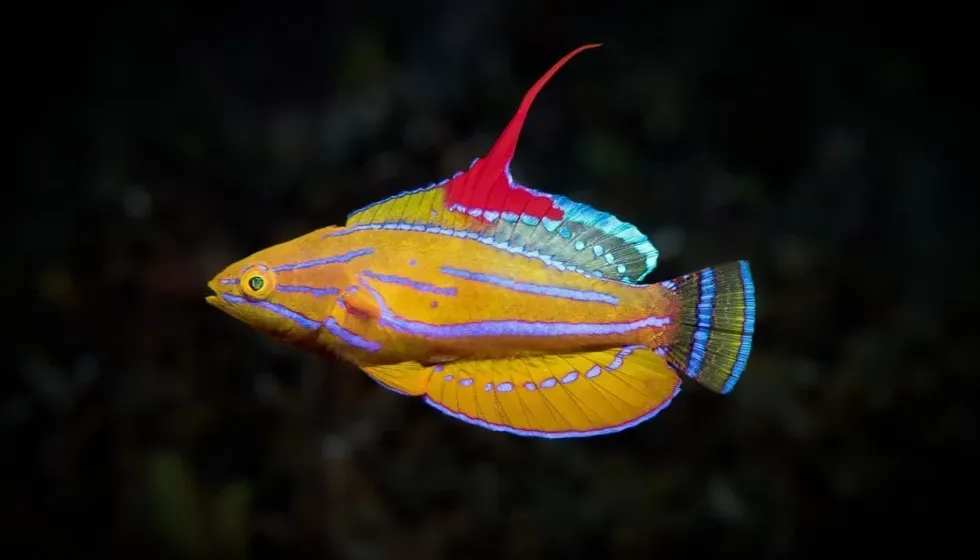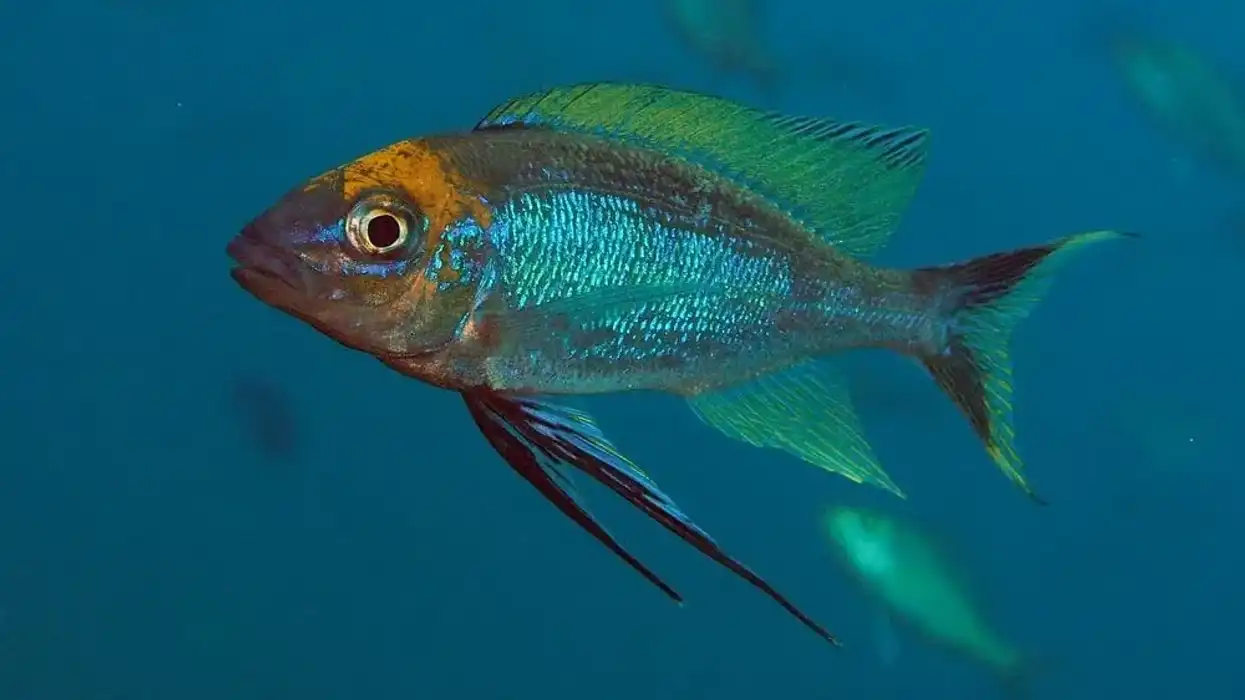The yellowfin flasher wrasse, scientifically known as Paracheilinus flavianalis, belongs to the genus Paracheilinus. It is one of the wrasse species of the Labridae family.
Known to be a show-stopper in aquariums, these flasher fish are calm and active and provide all the glitter and glory to that community reef aquarium. They are small yet stunning fish. They have color filaments hanging on their dorsal fin, which are bright yellow or orange.
The males are attractive in these species, so always try to allure the females with their flashing courtship displays. They acquire their name from the electric neon colors they flash during the mating.
These yellowfin flashers can grow to a maximum length of 3.1 in (8 to 8.5 cms). They are endemic to Indonesia and northwestern Australia.
Furthermore, if the above content has interested you, we have engaging articles on yellow boxfish facts and donkey fish facts.
Yellowfin Flasher Wrasse Interesting Facts
What type of animal is a yellowfin flasher wrasse?
The yellowfin flasher wrasse fish of the genera Paracheilinus is a fish. It is a deliberately colored beautiful aquarium and reef fish.
What class of animal does a yellowfin flasher wrasse belong to?
The Paracheilinus flavianalis is a fish, and it belongs to the class Actinopterygii.
How many yellowfin flasher wrasses are there in the world?
The exact count of their population is not evaluated, as they are reef fish they hide between the rocks of the reef surface.
Where does a yellowfin flasher wrasse live?
The Paracheilinus flavianalis live in the corals of marine habitats. They are native to the Eastern Indian Ocean of Indonesia and northwestern Australia.
What is a yellowfin flasher wrasse's habitat?
The yellow flashers prefer outer reef slopes, corals, or the base of seaward slopes. They are reportedly found at depths of 114 ft (34.7 m). They need plenty of rocky areas to build their sleeping area and to hide.
Who do yellowfin flasher wrasses live with?
The yellowfin flasher wrasses are solitary animals. They either live alone or in small groups. During breeding, a single male can be found with a group of females.
How long does a yellowfin flasher wrasse live?
These yellowfin flasher wrasses are known to live for four to five years in captivity.
How do they reproduce?
The yellowfin flasher wrasse fertilizes through spawning. A single male with more than three females is the ideal situation. These flashers spawn with Pelagic eggs hence require huge water bodies for breeding. The wrasses are known to lay a litter of 1000 eggs into the sea.
What is their conservation status?
The yellowfin flasher wrasse is listed as of Least Concern by the International Union for Conservation of Nature.
Yellowfin Flasher Wrasse Fun Facts
What do yellowfin flasher wrasses look like?

*We've been unable to source an image of a Yellowfin Flasher Wrasse and have used an image of its habitat. If you are able to provide us with a royalty-free image of a Yellowfin Flasher Wrasse, we would be happy to credit you. Please contact us at hello@kidadl.com.
The yellowfin flasher wrasse is a small fish of the Paracheilinus genera. They are attractive fish with a long filament at the dorsal fin, pink abdomen, with three vertical white bands. Their fins are transparent as well.
The dorsal fin on the posterior side is yellow, and the base is red, and the rump is transparent. A faint blue line runs across the body from the caudal fin in the males.
The pelvic fins are white or blue, pink caudal fin, and white pelvic fins. The females are orange-red with a black spot on the caudal fin. The elongated dorsal fin is absent in females.
How cute are they?
Divers refer to this fish as the peacock of the sea. They are peaceful, colorful, and active jumpers. They are harmless to other fish species and are safe for a community reef aquarium.
How do they communicate?
The flasher wrasse Paracheilinus earn their name, accounting for their flashing behavior. They inherit this behavior of displaying colors which is an act of courting display by the male flasher wrasse. While doing so, they also keep flashing their fins. These fish also flash aggressively while territory fights.
How big is a yellowfin flasher wrasse?
The flasher wrasse Paracheilinus is a small fish. Its length is 3.1 in (8 cm). This is the normal length of a flasher wrasse.
How fast can a yellowfin flasher wrasse swim?
The yellowfin flasher can swim all over its territory of corals really fast, but their exact speed is unknown. However, they generally swim with their fin much closer to their body.
How much does a yellowfin flasher wrasse weigh?
There is no established record of the weight of these species, but these are small fishes with negligible weight.
What are the male and female names of the species?
The male and female wrasse are called male yellowfin flasher wrasse and female yellowfin flasher wrasse. A group of these fish is addressed as a school, draft, run, or shoal. Also, these fish are hermaphroditic, and they can change their sex from female to male in the absence of male wrasse.
What would you call a baby yellowfin flasher wrasse?
The baby yellowfin flasher is called a juvenile.
What do they eat?
The flasher wrasse Paracheilinus eat zooplankton, brine shrimp, and Mysis shrimp. Fish in aquariums should be fed with foods enriched with vitamins like marine pallet food and high-quality marine food.
Are they poisonous?
Flasher wrasses are not poisonous.
Would they make a good pet?
These are stunning fish with bright colors are alluring to the human eye. Their significant flashing displays are a visual treat. These can coexist with other species of fish and are primarily harmless. One cannot let go of the thought of having this aquarist at the community reef aquarium.
Did you know...
Flasher fish are sexually dimorphic, and the males are bestowed with more colors than the females. The male yellowfin flasher wrasse owns bright colors of orange, red yellow with the characteristic blue flasher streaks that highlight when the fish are excited.
These yellowfin flashers need open tanks with a tank size of 50-55 gallons (227.3-250 l). They need to be fed with high-quality foods and to be taken proper care of.
While feeding in the aquarium, one should take care that foods are distributed equally to tank mates as these fish swim rapidly and swallow the food. In addition, the aquarium canopy should be tightly closed as these yellowfin flashers can jump out from small holes.
These fish need lots of rocky areas in the corals with hiding places.
A more attractive aquarium fish is the yellowfin flasher fairy wrasse, which is local to the corals of the western Pacific Ocean from Indonesia to the Philippines.
Are flasher wrasses aggressive?
Flasher wrasses are rarely aggressive with other fishes. Instead, they are calm and coexist with other wrasse species or other fish, except during courting display, where males start flashing with the change of coloration and during territorial disputes with other males.
Do flasher wrasse bury themselves?
Flasher wrasses are cocoon mucus spinners as an act of sleeping behavior. They are not sand sleepers. They do not bury themselves in the sand while sleeping at night. Instead, the flasher wrasse spins the cocoon with their mucus and stays still in it, protecting them from predators and masks their scent.
Here at Kidadl, we have carefully created lots of interesting family-friendly animal facts for everyone to discover! Learn more about some other fishes including humphead wrasse facts and exquisite wrasse facts.
You can even occupy yourself at home by coloring in one of our free printable yellowfin Flasher wrasse coloring pages.









